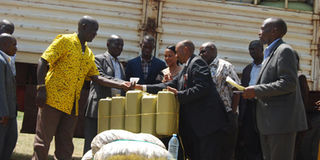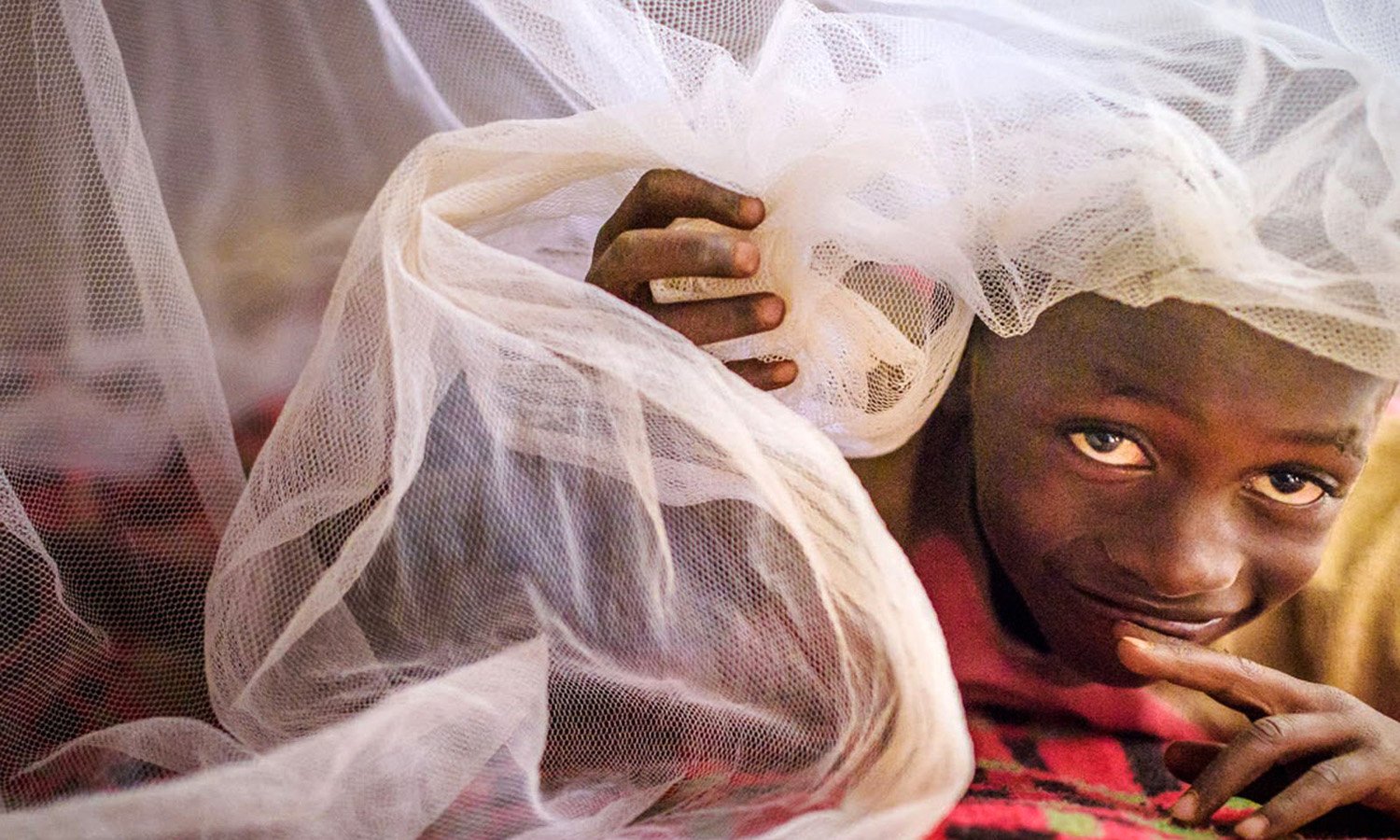Thanks for relief items, but fix flooding too - Ntoroko leaders

State minister for Disaster Preparedness Musa Ecweru (L) hands over relief items to Ntoroko District officials on Wednesday. Photo by Ruth Katusabe
What you need to know:
Demand. Ntoroko leaders have demanded that government should find ways of stopping rampant flooding in the district, that displaces hundreds of people every year and destroys property. They say providing relief items such as food, tents, blankets and jerricans is not enough, write Felix Basiime and Ruth Katushabe
On Saturday night, November 1 Ms Sofia Byanjeru, 50, a resident of Budiba Sub-county in Ntoroko District awoke to a wet bed.
At first she thought her children had wetted her bed but to her shock she realised floods had submerged her house.
“The whole house was full of water to about two feet above the ground,” Byanjeru says, adding “I made an alarm and fled with all family members for our dear lives. Other people in the neighbourhood had started to escape, so we were ferried on a canoe to Budiba centre and we had to pay Shs 1,000 per person.”
Ms Byanjeru is among the more than 5,000 people in Ntoroko who were last week displaced by floods caused when rivers Lamia and Semliki bust their banks.
The floods destroyed houses, roads, crops and killed several livestock and poultry.
The affected areas include: Budiba, Kanara, Bweramule, Butungama and parts of Rwebisengo Town Council.
The floods compelled at least 474 Primary Seven candidates in Ntoroko District to do their Primary Leaving Examinations in tents after some classrooms and roads were submerged.
Floods are a chronic problem in Ntotoko which plague the district every rainy season, displacing hundreds of people and leaving a trail destruction.
Every time floods occur houses are damaged; crops destroyed and roads are rendered impassable, hindering education, livelihoods and provision of social services.
According to environmentalists and Ntoroko residents, the flood waters this time came in bigger volumes. Environmentalists say this is an indicator of increased environment degradation upstream of River Semliki and downstream in Ntoroko.
Ntoroko officials have called upon the government to go beyond providing relief items such as food, tents and blankets to flood victims as it always does whenever floods occur in the district, and find ways of stopping the floods.
The district chairperson, Mr Timothy Kyamanywa, recently told Vice President Edward Ssekandi: “We are tired of getting relief aid every year whenever the district is affected by floods. So find other means of stopping these floods because government is spending much to get relief aid for the affected people.”
Almost every year, the State Minister for Disaster Preparedness, Mr Musa Ecweru, visits Ntoroko to deliver relief items to the people affected by both floods and drought.
Government and other bodies such as the Red Cross have done this for the last four years since the area is affected by floods in rainy seasons and by drought in dry seasons.
The district environment officer, Mr Herbert Kamuhanda, explains that there are a combination of factors that bring About the floods.

Children in a submerged hut in Budiba in Ntoroko District. Floods are a chronic problem in Ntotoko.
He says uncontrolled human activities causes River Semliki to bust its banks.
Mr Herbert adds that glaciers on Mount Rwenzori are melting more rapidly due to climate change, thereby releasing more water to the streams that feed River Semliki.
“Other waters stream into the Semliki valley, part of the Western Rift Valley causing floods,” he says.
Environment experts say overgrazing, and other alterations to the watershed have caused bank erosion and frequent changes to the course of River Semliki.
Mr Kamuhanda says: “Most rivers: Lamia, Ndugutu, Nyahuka, Ngite and Kirumia (all in Bundibugyo) are watered by the glaciers on Mount Rwenzori and all empty into River Semliki.
There are several human activities causing flooding and the changing course of River Semliki.”
He adds: “At Rwamabare, Kakahenda village in Ntoroko District, water flows to the communities due to siltation of River Semliki. Upstream in Bundibugyo, people cultivate on the river banks and mine sand. At Ntandi (also in Bundibugyo), people throw waste into River Kirumia which is a middle stream of River Semliki causing siltation and the river bed rises causing banks to bust”.
Mr Kamuhanda says at Rukora in Bweramure (Ntoroko), there has been over stocking of animals on free range system and the pastoralists have created several watering points on the river banks causing siltation leading to the river changing its course.
He adds that at Masaka in Butungama and at Kiranga in Rwebisengo Sub-county, people dig channels to divert water from River Semliki to water their animals or catch fish and when the river busts its banks, these channels lead water to the communities.
According to research conducted by the Climate Change Unit and the Ministry of Water, 198.5 hectares of ice disappeared between 1906 and 2006 on Mount Speke, one of the highest peaks on the Rwenzori range. Most of the melting occurred after 1987.
Ntoroko officials and environment experts have proposed several solutions to address the flood problem, including building a dam to store the excess water from River Semliki during the rainy season and using it during the dry season.
“It is very costly but the excess water can be tapped and dammed and used during the dry season,” Mr Kamuhanda says.
Hydrological and climate change experts advise that something must be done to address siltation and climate change in the catchment areas of River Semliki to control flooding downstream.
“River bank regulation must be enforced, especially in Ntoroko District where the law requires 100 metres protection zone where there must be minimal human activities to allow natural rejuvenation,” says Mr Jeconious Musingwiire, the western region National Environment Management Authority awareness officer.
He adds: “Flooding is mainly contributed by siltation, so siltation should be controlled and to tame the effects of climate change, the whole catchment area where this river drains from must promote afforestation.” The recent floods despite disrupting PLE exams and displacing hundreds of people, have brought some fortune too.
Fish from River Semliki have ended up in shallow flood waters in areas far away from the river where several people catch them easily and sell them at affordable prices to displaced people.
A big fish goes for between Shs15,000 and Shs20,000.
Some youth have taken advantage of the floods to make money through offering transport services on their canoes.
They charge Shs1,000 per person for the shortest distance.
River Semliki
Semliki River flows northwards from Lake Edward in the Democratic Republic of the Congo across the Uganda border, through western Uganda in Bundibugyo and Ntoroko districts near the Semliki National Park. It empties its water into Lake Albert.
According to the World Wildlife Fund, the Semliki catchment area is under a lot of pressure due to increasing population and poor management of natural resources.
Deforestation and uncontrolled cattle grazing is leading to widespread erosion.
This, together with the melting of ice on the Mount Rwenzori, a result of climate change, has resulted in siltation, affecting water quality and changing the river course significantly over the years as it enters Lake Albert.
Ntoroko District
District: Ntoroko District is located west of the Rwenzori Mountains. It was carved out of Bundibugyo District in 2010.
It is bordered by the Democratic Republic of the Congo to the west, Hoima District to the northeast, Kibaale District to the east, Kabarole District to the south and Bundibugyo District to the southwest.
Economy: Its major economic activities are fishing, farming and business. Cattle and goat rearing is in Rwebisengo and Nombe, crop farming in Karugutu, Butungama and Bweramule while fishing in Kanara.
Flood woes: According to the district chairman, Mr Timothy Kyamanywa, the floods have stretched the district budget and resources by increasing the cost of containing malaria, especially among the children and malaria drugs are running out.




